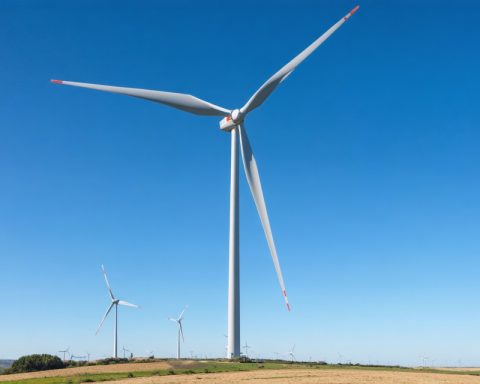- Wave energy conversion utilizes the ocean’s kinetic and potential energy to generate electricity, offering a sustainable energy solution for remote areas.
- This technology involves mechanical buoys that convert wave momentum into electric power with minimal environmental impact.
- Wave power projects, such as those in the Azores, demonstrate the practicality of localized renewable energy without disrupting ecological balances.
- Wave energy’s predictability and potential for grid stability make it an appealing alternative to wind and solar power.
- Challenges include engineering resilient systems to withstand harsh conditions, but ongoing innovation is addressing these obstacles.
- Wave energy highlights a path to energy independence for isolated communities, reducing reliance on fossil fuels.
Gentle ocean waves may appear serene from a distance, but beneath their surface, there lies a gargantuan force that clean energy innovators are now tapping into. In the remote corners of the world, where grid extension is costly and fossil fuel deliveries are unreliable, wave energy conversion emerges as a beacon of hope and sustainability.
Wave power technology utilizes the kinetic and potential energy of ocean waves to generate electricity. Picture a dance of mechanical buoys bobbing on the surface, each rise and fall transforming wave momentum into electric power. Imagine shorelines dotted with these ingenious devices, quietly and tirelessly working day and night with minimal environmental impact.
This technology’s potential isn’t just theoretical. Take, for example, the Azores, a volcanic archipelago in the midst of the Atlantic Ocean. Here, wave power developers are piloting projects that aim to deliver reliable and clean power to local and sustainable communities. Such initiatives are not mere experiments; they are vivid illustrations of how localized renewable energy solutions can thrive without altering ecological balances.
The appeal of wave energy, aside from its renewable nature, lies in its predictability. Ocean currents move with a stability and constancy that wind and solar sources can’t always guarantee. Coupled with cutting-edge energy storage advances, this predictability offers electrical grid stability crucial for communities that depend heavily on consistent energy flows.
Yet, the road to harnessing wave energy isn’t without obstacles. Engineers grapple with the challenge of building resilient systems to weather nature’s occasional fury. Continuous innovation and rigorous testing are paving the way for steadfast designs capable of enduring the harshest conditions while consistently converting ocean swell into usable energy.
As island governments and remote coastal communities explore these promising ventures, they illuminate a path toward energy independence—a future where reliance on carbon-heavy fuels becomes a relic of the past.
Takeaway: Wave power stands as a testament to human ingenuity and nature’s generosity, offering isolated and ecologically sensitive areas a renewable lifeline. As investments flow and technological prowess enhances, these quiet tides may well surge as a cornerstone of our resilient, sustainable future.
Unlocking the Potential of Wave Energy: The Future of Clean Power
Understanding Wave Energy Conversion: More Than Meets the Eye
Wave energy, generated from the ocean’s surface motion, is a largely untapped renewable energy source with significant potential. It’s estimated that if we could capture just a fraction of the world’s wave energy, it could meet a substantial proportion of global electricity demand. This highlights the importance of developing efficient wave energy conversion systems.
How Wave Energy Conversion Works: A Step-by-Step Guide
1. Wave Capture: Buoys or other floating devices harness the kinetic energy from the rising and falling waves.
2. Energy Transformation: The motion is converted into mechanical energy through pistons or turbines.
3. Electricity Generation: The mechanical energy powers a generator to produce electricity.
4. Energy Storage and Transfer: Generated electricity is stored or transmitted to the power grid for distribution.
Real-World Use Cases and Market Potential
Wave energy is especially viable for island nations and remote coastal communities where electricity generation can be expensive and carbon-intensive. Regions like the Azores and Scotland are pioneering testbeds, showing that wave energy can supplement local grids and reduce reliance on imported fossil fuels.
Industry Trends and Market Forecasts
The wave energy market is projected to grow at an impressive rate due to increasing investment and technological advancements. According to the International Energy Agency (IEA), wave energy could provide up to 10% of the global demand by 2050.
Challenges and Limitations
While promising, wave energy faces several hurdles:
– Durability: Equipment must withstand harsh ocean conditions like storms and saltwater corrosion.
– Cost: Initial setup and maintenance costs can be high, though they may decrease with technological advancements and increased adoption.
– Environmental Impact: Though minimal, the ecological impact on marine life must be constantly assessed and mitigated.
Pros and Cons Overview
Pros
– Predictability: Waves offer more consistent energy compared to solar and wind.
– Zero Emissions: No greenhouse gases are emitted during operation.
– Space Efficiency: Facilities can be positioned at sea without utilizing land space.
Cons
– High Initial Costs: Installation and maintenance can be costly.
– Technical Challenges: Engineering devices that can withstand ocean conditions is complex.
– Limited Locations: Only certain geographical areas are suitable for wave energy projects.
Security and Sustainability Considerations
Wave energy can enhance energy security by reducing dependence on fossil fuels and offering a reliable power source. Its sustainability rests on the minimal carbon footprint and the ability to integrate with other renewable sources.
Quick Tips for Embracing Wave Energy
1. Evaluate Location Suitability: Assess geographical and oceanographic conditions.
2. Collaborate with Innovators: Work with tech companies pioneering durable and efficient designs.
3. Secure Funding: Explore government incentives and private funding dedicated to renewable energy initiatives.
For more information on renewable energy innovations, visit the International Energy Agency. Explore how wave energy feeds into the broader landscape of sustainable power solutions and aims to revolutionize how we generate electricity.











